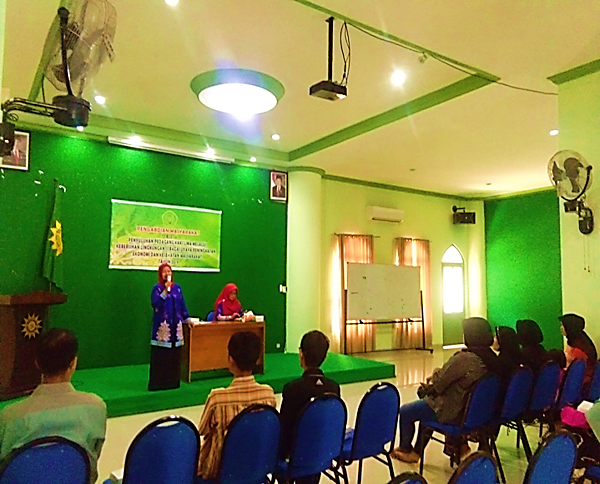Penyuluhan Kelompok Pedagang Kaki Lima melalui Kebersihan Lingkungan sebagai Upaya Peningkatan Ekonomi dan Kesehatan Masyarakat Counseling of Street Vendors Group through Environmental Cleanliness as Efforts to Improve Economy and Public Health
Main Article Content
Abstract
When you hear the term Street Vendors (PKL), it comes to mind that conditions are slum, dirty, irregular, black, dirty, unhealthy, without tariffs on the price of food or drink menus. Then its existence disturbed the view, seized the sidewalks of the road so that it became the target and object of the order officers because it was selling on the side of the road which was not an area for sale. The police pursued to be disciplined, disappeared briefly appeared again, cat and mouse with trantib officers. Especially in the middle of the city, the protocol road, which is often for officials to pass guests or state guests. Street vendors on one side disturb the eyes, with carts that are worn, dirty, but their existence is needed by the community. They are often referred to as informal sector actors who remain vulnerable to the fluctuation of the dollar. The proof at the time of the company's financial crisis went bankrupt, but street vendors still exist to sell. Even employees who are laid off and laid off become street vendors. In Palangkaraya Street Vendors are almost biased to be found on every street corner, Perda No. 13 of 2009 which regulates the Arrangement, Ordering, and Supervision of Street Vendors seems to have not run optimally. Through this community service, we would like to participate in providing counseling on how beneficial it is to maintain and regulate the street vendors' environment as an effort to improve the economy and public health.
Downloads
Article Details
Authors who publish with this journal agree to the following terms:
- Any article on the copyright is retained by the author(s).
- Author grant the journal, right of first publication with the work simultaneously licensed under a Creative Commons Attribution License that allows others to share work with acknowledgment of the work authors and initial publications in this journal.
- Authors are able to enter into a separate, additional contractual arrangements for non-exclusive distribution of published articles of work (eg, post-institutional repository) or publish it in a book, with acknowledgment of its initial publication in this journal.
- Authors are permitted and encouraged to post their work online (e.g., in institutional repositories or on their websites) prior to and during the submission process, as can lead to productive exchanges, as well as earlier and greater citation of published work.
- The article and any associated published material is distributed under the Creative Commons Attribution-ShareAlike 4.0 International License
References
Ermandara, D. 2016. Risiko Bisnis Dan Siasat Pedagang Kelana: Studi Kasus Pasar Jumat Asy-Syiraj Di Kota Bandung. Umbara: Indonesian Journal of Anthropology. 1(1):13-25. https://doi.org/10.24198/umbara.v1i1.9601
Hadinata, M., Ruchimat, T. 2018. Analisis Terhadap Kebijakan Pemerintah Provinsi DKI Jakarta Tentang Penutupan Jalan Jati Baru Raya Untuk Pedagang Kaki Lima. Jurnal Hukum Adigama. 1(2):1-25.
Hendra, D. 2019. Solidaritas Sosial Pedagang Kaki Lima terhadap Tingkah Laku Konsumen di D.I Yogyakarta. Populika. 7(1):1-11.
Ismanidar, Amirullah, Usman, S. 2016. Persepsi Masyarakat Terhadap Pedagang Kaki Lima Di Kota Banda Aceh. Jurnal Ilmiah Mahasiswa Pendidikan Kewarganegaraan. 1(1):147-157.
Pulungan, M.S. 2017. Perlindungan Hukum dan Pembinaan Pedagang Kaki Lima di Balikpapan. Matra Pembaruan: Jurnal Inovasi Kebijakan. 1(1):11-21. https://doi.org/10.21787/mp.1.1.2017.11-21
Puspitasari, D.E. 2010. Penataan Pedagang Kaki Lima Kuliner untuk Mewujudkan Fungsi Tata Ruang Kota di Kota Yogyakarta dan Kabupaten Sleman. Mimbar Hukum. 22(10):588-606. https://doi.org/10.22146/jmh.16244
Rochaida, E. 2016. Dampak Pertumbuhan Penduduk Terhadap Pertumbuhan Ekonomi Dan Keluarga Sejahtera Di Provinsi Kalimantan Timur. Forum Ekonomi: Jurnal Ekonomi, Manajemen dan Akuntansi. 18(1):14-24. http://dx.doi.org/10.29264/jfor.v18i1.42
Saputra, R.B., Indrawati. 2014. Profil Pedagang Kaki Lima (PKL) Yang Berjualan Di Badan Jalan (Studi Di Jalan Teratai Dan Jalan Seroja Kecamatan Senapelan). Jurnal Online Mahasiswa Fakultas Ilmu Sosial dan Ilmu Politik Universitas Riau. 1(2):1-15.
Saragih, R.T. 2016. Implementasi Perda Kota Surabaya No. 9 Th 2014 Tentang Penyediaan Ruang Bagi Pedagang Kaki Lima Di Pusat Perbelanjaan Dan Pusat Perkantoran Di Kota Surabaya (Studi Kasus Di Kawasan Terminal Bratang Kecamatan Gubeng). JPAP (Jurnal Penelitian Administrasi Publik). 2(1):33-50. https://doi.org/10.30996/jpap.v2i01.699
